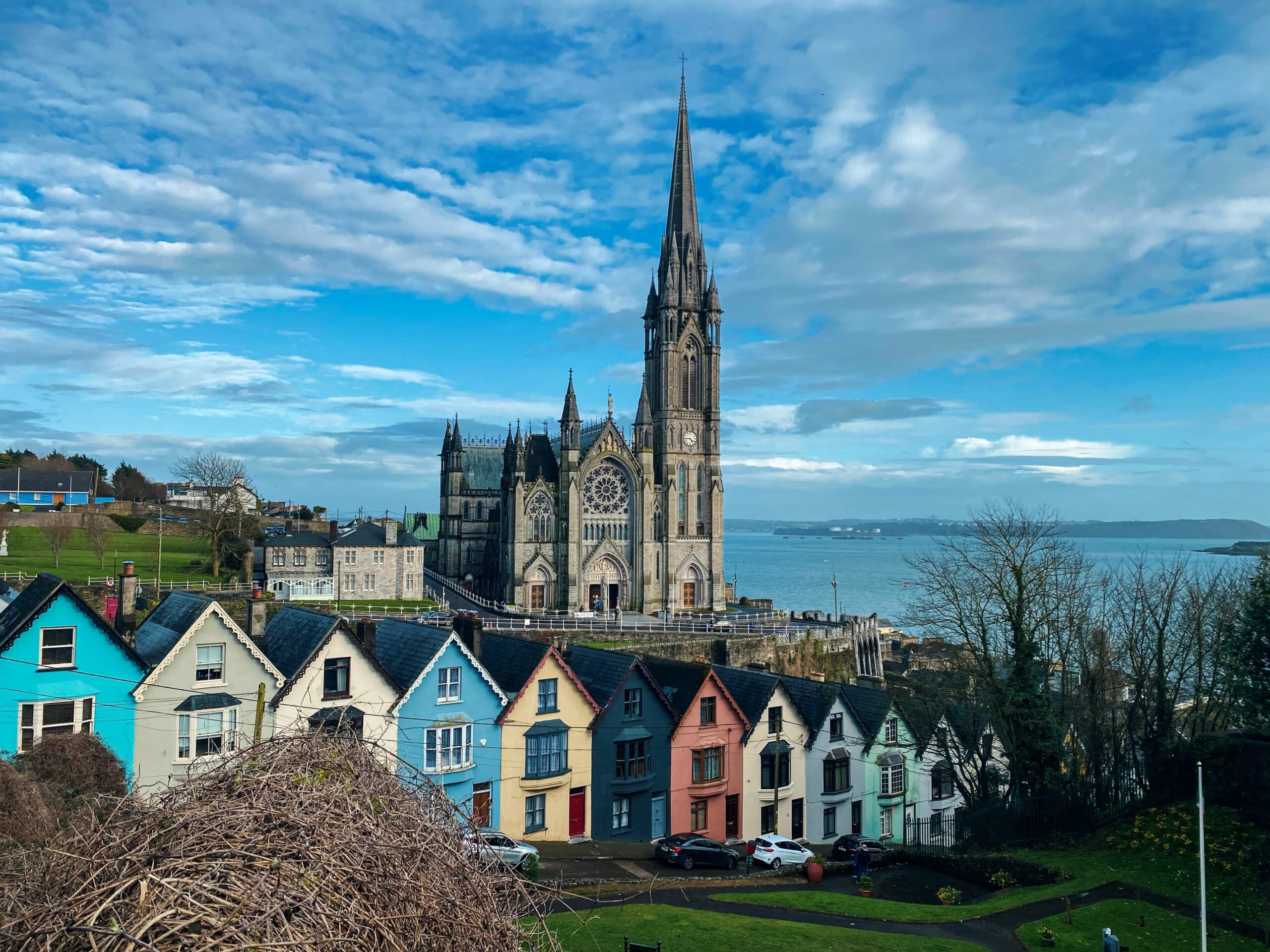If you have Irish blood or want to incorporate this culture into your special day, you can follow some popular Irish wedding traditions and rituals.
These traditions can make your wedding day extra memorable and meaningful, from attire to toasts to flowers.
14 Irish Wedding Traditions and Rituals
1. Celtic Wedding Dress
Many brides add Irish lace to their dress or veil, hidden symbols of luck like horseshoes and shamrocks, or the color blue. Most people associate green with Ireland, but for centuries, their lucky color was blue.
Many Irish brides wore blue wedding dresses to start their marriage with as much luck as possible. This tradition is partially where the “something blue” tradition emerged.
Modern brides typically have blue accents or hidden blue details, but you can also have an entirely blue dress!
2. Men in Kilts
What Irish wedding would be complete without a classic Irish kilt? Rather than suits and tuxedos, men at Irish weddings wear ceremonial kilts. If you want to make your wedding as Irish as possible, ask your male guests to try and wear kilts!
But you can also have the groom and men at the wedding party wear kilts. Sometimes wedding suits can be bland and unoriginal, especially compared to dazzling bridesmaid dresses. To kick the men’s attire up a notch, they can wear a kilt with the traditional Brian Boru jacket.
3. Carry a Little Luck
As people know, the Irish are all about luck! Brides will carry lucky tokens or incorporate blessed symbols into their wedding. The Celtic knot is a classic symbol of Irish luck; many add this detail to their table settings or ceremony decor.
Other lucky items include horseshoes, a wishing ring, anything blue, and shamrocks. Brides and grooms frequently carry an Irish handkerchief made from Irish linen.
Certain Irish coins are also lucky but are often a gift to the bride and groom. If you want to incorporate Irish luck into your wedding, carry a mini horseshoe or keep a Celtic knot on your person.
Irish culture often discusses how evil fairies can steal children or new brides away. Carrying luck around with you can ward off these malicious fairies and protect your wedding and marriage.
4. Tying the Knot
This ritual is one of the most meaningful and touching parts of an Irish wedding ceremony. Most people are familiar with the term “tying the knot.” At Irish weddings, they literally do this, entwining the bride and groom’s hands together with a ribbon or rope.
This ritual symbolizes their commitment and how their lives are now bound together forever. The priest or officiant typically recites passages about love while tying their hands.
This tradition can be during the vows or in place of vows. The ritual is called “handfasting”, and some couples will use the same ropes their parents did if they’re available to make it even more special.
5. Claddagh Rings
Claddagh rings are a classic piece of Irish jewelry meant to indicate one’s relationship status. When the heart on the ring points outward, the person is not yet married. But when they flip the ring around, it indicates they’re married.
Many people will use their Claddagh ring as an engagement and wedding ring, turning it around during the ceremony instead of adding another ring to their finger.
The rings have clasped hands holding a heart, and the band typically features Celtic knots or similar details. But people will also wear Claddagh rings on other fingers as an Irish luck sentiment.
6. Wedding Bells
Church wedding bells are one thing, but Irish bells are even more special and meaningful. Rather than church bells, Irish wedding bells are handheld bells rung by guests of the wedding to protect the bride and groom from evil spirits and wish them luck and happiness.
This tradition is super fun because all your guests can take part and the combination of ringing bells makes the ceremony joyous and exciting. The noisiness shows how much your family and friends support you and create a lively and merry atmosphere.
Some couples also have small bells engraved and given to their guests as presents! The bride or groom may also carry a bell for good luck or make them a central wedding decor theme.
7. A Meade Toast and Irish Spirits
The Irish are known for their love of spirits, and one of the most traditional and old drinks is meade! Meade is wine made from honey, and it’s common for the first toast at a wedding to be with meade.
The bride and groom also toast each other at the reception using a glass of meade. The meade toast is an essential tradition between the bride and groom, but what Irish wedding would be complete without whiskey, Guinness, and other popular spirits?
Irish weddings usually offer mist liqueurs, whiskey, cream liqueurs, ciders, and beers.
8. Uilleann Pipes and Celtic Harps
People think of the bagpipes as an Irish instrument, but it’s actually a Scottish instrument. For authentic Irish music, people use Uilleann pipes, which create a sweeter sound.
Some Irish weddings have one piper, but you can have several. Because the Uilleann pipes are softer and smaller than bagpipes, they can play in the church during the ceremony. It’s customary for the piper to lead the newly married couple out of the church as they play!
Another traditional Irish instrument is the Celtic harp, which you can see on the Irish flag and the Guinness label. The harp creates an ethereal and soothing but happy sound.
9. An Irish Jig
If you have the harp and pipes, it only makes sense for an Irish jig to break out! The Irish love to dance in their unique way. A traditionally Irish wedding will have Irish dancers perform, usually before or right after the couple’s first dance.
Modern Irish weddings do this less, but the wedding party or couple will perform a quick Irish jig or River Dance-inspired routine. You need to have Irish music for an Irish jig, so these two traditions go hand in hand.
10. Weekday Weddings
Irish weddings should only be on weekdays for good luck. Once upon a time, Irish weddings were always on Sunday, but this became taboo, leading to the new tradition of weekday weddings. There’s a rhyme that explains what days to get married:
“Monday for health,
Tuesday for wealth,
Wednesday the best day of all,
Thursday for losses,
Friday for crosses and
Saturday no day at all.”
Today, Irish people view Wednesday as the best day to get married. But Monday and Tuesday are also acceptable options. The time of year also matters in Irish culture. And there is a poem for that rule too!
“Marry when the year is new, always loving, kind, and true.
When February birds do mate, you may wed, nor dread your fate.”
“If you wed in bleak November, only joy will come, remember.
When December’s rain fall fast, marry and true love will last.”
Irish people avoid getting married between May and August, with the best time being December and January. This tradition has to do with farming seasons.
11. Goose for Dinner
At an Irish wedding rehearsal, you’re supposed to have goose for dinner! Some people serve goose at the wedding reception as well, but it’s customary for the bride’s family to make the groom and his family goose the evening before the big day.
This tradition is called “aitin’ the gander”. This ritual is where the saying “His goose is cooked” comes from. After this dinner, there was no way for the groom to get out of the wedding.
While this history is a little uneasy, people still gather both immediate families for a pre-wedding goose as a celebratory occasion, not an intimidating obligation.
12. Local Flowers
A stunning and precious Irish wedding tradition is decorating with locally grown flowers, ideally wildflowers. Not only is this a sweet tradition, but it can save the bride and groom a lot on wedding costs!
Family and friends at the wedding party typically collect the wildflowers the day of or the day before the wedding, so everything is fresh and full of life.
Irish weddings also have tons of flowers, at the ceremony, reception, on the wedding car, in the bride’s hair, and anywhere else they can go.
13. Braids and Lace
Traditionally, Irish brides wear their hair and braids and add braided accents to the wedding. For example, many Irish wedding cakes have braided frosting designs, and table settings will have braided napkins. Along with braids, Irish lace also appears in wedding accents.
People will add Irish lace designs to their wedding cake, to their veil, and of course, to their wedding dress. Bridesmaids will also have braided hair or Irish lace on their dresses. You can also use Irish lace to wrap the flower bouquets!
14. Irish Poetry
Irish people like to talk, so Irish weddings also have more toasts than other weddings. People make toasts before the bride and groom even arrive at the reception.
Many toasts are Irish poetry passages about love and commitment; family members may even recite Gaelic poetry if they know how to read it.




